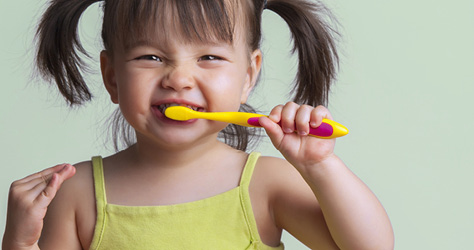Keep their little toothie pegs in tip-top condition...
From toothbrush techniques and toddler toothpaste to happier tooth brushing, it’s all here…
At a glance
- What you'll need to care for their teeth
- How to brush their teeth
- What they should eat and drink

De-ja-vu?
Most toddlers have started the teething process by 12 months and it's important to start brushing teeth twice a day as soon as teeth are visible. The molars – the large teeth at the back of the mouth – usually arrive a little later. The first molars usually appear around 12-16 months, with the second molars following at 20 months to two and a half years. If they’ve (again) started showing signs of teething there are plenty of products, medicines and techniques which you can use to comfort them.
As soon as teeth become visible you should brush twice a day - it's never too early to start!
Toddler toothpastes
Fluoride can help build strong tooth enamel and prevent tooth decay.
It's important to use a toothpaste containing no less than 1,000 parts per million of fluroide.
Too much fluoride can cause 'fluorosis' leading to white spots on teeth, so it is important to use only a smear of toothpaste for children up to the age of three. From the age of three to six years a small pea size of toothpaste can be used.
Supervise tooth brushing and encourage them to spit out toothpaste. Keep toothpaste out of reach.
Clean teeth twice a day, before they go to bed at night and on one other occasion.
Brushing
Brush twice a day using a soft toddler toothbrush and toothpaste. Let them see you brushing your teeth and try to make it fun so that it’s an enjoyable part of your routine.
Brushing teeth after breakfast and before bed ensures teeth aren’t coated with remnants from mealtimes for long. After bed-time brushing, give them water rather than milk or juice as these can leave a layer on teeth which could cause tooth decay.
Use a circular ‘scrubbing’ technique, ideally around each tooth.
Happy teeth
Most toddlers love the feeling of independence they get from cleaning their own teeth. So if yours is resistant let them try doing it themselves. You could also let them choose their own toothpaste or toothbrush. Check afterwards though, to ensure all food is removed. You could always let them try cleaning your teeth while you clean theirs! Keep it fun and part of the routine and they will eventually enjoy it. Or at least accept it.
Diet
Give your toddler drinks from a cup and either milk or water.
A good supply of calcium and vitamin D will keep little teeth strong and build great foundations for adult teeth. Dairy is a well-known source of calcium. Other calcium-rich foods include salmon, beans and green, leafy vegetables such as broccoli.
We all know sugar is bad for teeth. But we also know it’s not always practical to eliminate sweets from their diet. The best thing is to limit sweets and when they have then let them eat a few in one go rather than eating them over a long period. This way, they can enjoy them, then brush their teeth, instead of allowing sugar to sit on the teeth for hours. Avoid sugar containing foods and drinks at bedtime.
Want to swap techniques for getting them enthusiastic about tooth brushing? Gearing up for that first trip to the dentist? Read our guide to toddlers and dentists.